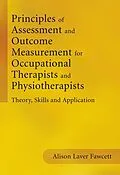This textbook on assessment and outcome measurement is written for both occupational therapy and physiotherapy students and qualified therapists. It begins by defining what is meant by assessment, outcome, evaluation and measurement and discussing the complexity of therapy assessment and measurement, including the challenge of measuring human behaviour and the impact of factors such as task demand and context, including the environment. Methods of data collection (e.g. observation, interview, standardised testing) and sources (e.g. self-report, proxy) for collecting information about clients are then reviewed, and the main purposes of assessment (e.g. descriptive, evaluative, predictive, discriminative) presented. The book then addresses the topics of standardisation, levels of measurement, reliability, validity and clinical utility. There is a chapter describing and applying models for categorizing levels of function to aid assessment and measurement. The concept of clinical reasoning and reflective practice is then explored. Application of principles is supported through detailed case studies and worksheets and the criteria for test critique and guidelines for choosing a particular assessment approach are discussed.
Autorentext
Alison Laver-Fawcett, PhD, OT(C)), DipCOT, SROT currently Modernisation Manager, Service Development (Provider Services) and Interim Professional Lead for Occupational Therapy, North Yorkshire and York Primary Care Trust.
Inhalt
Introduction (Alison Laver Fawcett, PhD, DipCOT).
Occupational Therapy and Physiotherapy.
Labels used for providers and recipients of therapy services.
The importance of the selection and application of terminology in practice.
Definitions of key terms.
Summary of definitions..
Chapter 1: The importance of accurate assessment and outcome measurement (Alison Laver Fawcett, PhD, DipCOT).
Chapter summary.
Assessment as a core part of the therapy process.
The impact of health and social care policy on assessment practice.
The demand for evidenced-based practice.
Implementation of evidence-based practice.
Levels of evidence and grades of recommendations.
The application of standardised assessments.
The use of standardised versus non-standardised assessments.
Benefits of applying standardised measures.
The requirement to demonstrate effectiveness.
A focus on client-centred practice.
The demand for robust clinical governance.
The use of standards, protocols, guidelines and care pathways.
The complexity of assessment.
The nature of therapeutic practice.
The nature of human occupation and occupational performance.
The nature of human function and the complexity of measuring functional outcomes.
The influence of the level of task demand.
The impact of familiarity on performance.
The influence of environment upon performance.
The constraints of the practice setting.
Conclusion.
The Big Question.
Chapter 2: Methods of assessment and sources of assessment data(Alison Laver Fawcett, PhD, DipCOT, Sally Payne, MSc, BSc, DipCOT and Claire Howell, BScOT (Hons)).
Chapter summary.
Methods of data collection.
Sources of Assessment Information.
Self-report.
Interviewing as a means of collecting self-report data.
Communication, insight and capacity issues.
Cultural issues and self-report data collection.
Examples of self-report assessments.
Proxy report.
Examples of assessments that use information from a proxy.
Measures that assess the proxy (e.g. Care-giver and parent burden scales).
Observational assessment methods.
Examples of observational assessment.
Combining methods.
Examples of how therapists combine different assessment methods.
Documentation.
Confidentiality.
Further reading.
Case Study: Scott, by Sally Payne and Claire Howell.
Reflecting on the data collection methods you use in your practice.
Study questions.
Chapter 3: Purposes of assessment and measurement (Alison Laver Fawcett, PhD, DipCOT and Karen Innes, BSc OT, DMS, Cert Counselling).
Chapter summary.
Timing of assessment in the therapy process.
Referral.
Initial Assessment.
Information Gathering.
Initial Assessment.
Ongoing evaluative assessment.
Review.
Purposes of assessment.
Descriptive assessments.
Discriminative assessments.
Predictive assessments.
Evaluative assessment.
Assessment for particular purposes.
Capacity assessment.
Assessment for tribunals.
Risk assessment.
Needs assessment - considering wider populations.
Sharing your purpose.
Case vignette: Mr Smith.
Service Evaluation.
Service Structures.
Patterns.
Process.
Service outcomes.
Service inputs.
Beginning a service evaluation.
Case study: service evaluation - The Development and initial evaluation of a Memory Activity and Self Help (MASH) Group by Karen Innes and Alison Laver Fawcett.
Reflecting on purposes of assessment in your own practice.
Study questions.
Chapter 4: Levels of measurement (Alison Laver Fawcett, PhD, DipCOT).
Chapter summary.
What is measurement?
?
The assignment of numbers for the purposes of assessment.
What are levels of measurement?
Nominal Scales.
Ordinal Scales.
Interval Scales.
Ratio Scales.
Application of different levels of measurement - issues to consider.
Guttman scaling.
Rasch analysis.
Applying concepts of levels of measurement to your own practice.
Study questions..
Chapter 5: Standardisation and test development (Alison Laver Fawcett, PhD, DipCOT).
Chapter summary.
Standardized assessments.
Why should therapists use standardised tests?
What is a standardised test?
What is an un-standardised assessment?
Standardisation.
Test construction decisions.
Criterion-referenced tests.
Norm-referenced tests.
Criteria for judging norms.
Obtained score.
Raw score.
Frequency distribution.
Mean.
Median.
Normal distribution.
Standard deviation.
Percentile Values.
Percentile rank.
Training and interpreting standardised test scores.
Psychometric properties.
Worksheets.
Study questions.
Chapter 6: Validity and clinical utility (Alison Laver Fawcett, PhD, DipCOT).
Chapter summary.
Definition of validity.
Content validity.
Construct Validity.
Factorial Validity.
Discriminative validity.
Criterion-related validity.
Concurrent validity.
Predictive validity.
Other types of validity.
Definition of Ecological validity.
Definition of External validity.
Establishing the overall validity of a test .
Face Validity.
Clinical utility.
Cost.
Time.
Energy and effort.
Portability.
Acceptability.
Examining validity and clinical utility issues: test examples.
Applying concepts of validity to your own practice.
Study questions.
Chapter 7: Reliability (Alison Laver Fawcett, PhD, DipCOT.)
Chapter summary.
Introducing the concept of reliability.
Defining reliability.
Reliability coefficients and standard error of measurement.
Level of significance.
Error of measurement.
